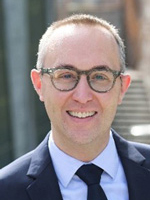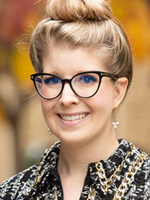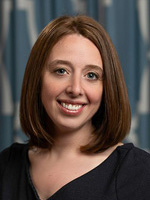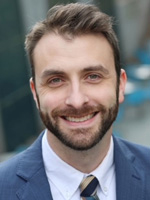
American Board of Medical Specialties (ABMS) Visiting Scholars are leading the charge to implement competency-based medical education (CBME) in graduate medical education (GME) across the specialties — and for good reason. From offering a more transparent and accountable training experience to emphasizing patient-centered care and outcomes, the principles of CBME resonate with these physician leaders.
Ignited during residency
The Visiting Scholars’ interest in CBME was ignited during residency. Daniel J. Schumacher, MD, PhD, MEd, from the Visiting Scholars class of 2014-2015, and Benjamin Kinnear, MD, MEd, from the class of 2022-2023, first became involved in CBME when they were chief residents. Dr. Schumacher served on the Accreditation Council for Graduate Medical Education’s (ACGME) initial Pediatrics Milestones Work Group while Dr. Kinnear became involved in a competency-based assessment innovation in internal medicine led by one of his mentors. “The principles of CBME resonated with me, and I thought the innovation work was a lot of fun,” Dr. Kinnear said. “Before long, I was hooked!” Both Brenessa Lindeman, MD, MEHP, FACS, from the class of 2018-2019, and Holly Caretta-Weyer, MD, MHPE, from the class of 2021-2022, began their foray into CBME by participating on an Association of American Medical Colleges (AAMC) initiative exploring entrustable professional activities (EPAs). Dr. Caretta-Weyer’s Visiting Scholars’ research project examined how Clinical Competency Committees can make summative and entrusted decisions about readiness for residents’ progression within a competency-based framework.

Dr. Schumacher, Director of the Education Research Unit and Professor with Tenure in the Department of Pediatrics at Cincinnati Children’s Hospital Medical Center, has implemented and led CBME efforts for his local residency program, led multiple national studies of both milestones and EPAs in pediatrics, guest edited an Academic Medicine supplement focused on EPAs, been a visiting professor for multiple specialties helping them to implement CBME, and advised a few ABMS Member Boards outside pediatrics in their CBME efforts. He currently chairs the American Board of Pediatrics’ CBME Committee.

Dr. Caretta-Weyer is the Associate Residency Program Director for the Stanford University Emergency Medicine Residency Program, Director of Evaluation and Assessment, and EPA/CBME Implementation Lead for the Stanford University School of Medicine. As the principal investigator on an American Medical Association Reimaging Residency Grant, she has been leading the charge on developing EPAs and a competency-based framework as well as programmatic assessment and education technology to support CBME implementation in emergency medicine. As such, she works with numerous stakeholders, such as the American Board of Emergency Medicine, Council of Residency Directors, and Society for Academic Emergency Medicine.

Dr. Lindeman is an Associate Professor and Vice Chair of Education in the Department of Surgery, Section Chief and Fellowship Director for Endocrine Surgery, and Assistant Dean for GME at the University of Alabama at Birmingham. She has played an integral role in drafting EPAs for the American Board of Surgery (ABS), American Association of Endocrine Surgeons, and AAMC. Dr. Lindeman also serves as a director of the ABS’ General Surgery Board, a member of the ABS Council, and Chair of the ABS Council’s Assessment Committee.

Dr. Kinnear, an Associate Professor of Internal Medicine and Pediatrics in the Division of Hospital Medicine at the University of Cincinnati Medical Center and Cincinnati Children’s, is part of a local team at the university working on CBME implementation and innovation. He is most interested in programmatic assessment and validity argumentation.
Appealing principles, benefits
When Dr. Schumacher participated in the milestones 1.0 work group, he had a broad interest in medical education. “But once I learned more about CBME, I was struck by the importance of approaching education in this way for the sake of learners and patients,” he said. “CBME posits that we should start with the end in mind – the competencies/outcomes needed of trainees to ensure they are able to provide the care that patients need.”
Dr. Lindeman appreciates that CBME takes into consideration that individuals develop knowledge, skills, and attitudes at different rates rather than defining progression through training based solely on time in a program. “The CBME framework provides a definition of the expectations for completion of training – the knowledge and skills that a practitioner in a specific discipline or graduate from a specific training program should have, Dr. Lindeman noted. “This provides substantially more transparency in training than has existed previously and allows trainees to take a more active role in their own education. Because of the volume of feedback and assessments obtained, it may also help us to better identify trainees who are struggling early on in their training in order to provide support,” she added.
“Patients and society hold us to a higher standard as a self-regulating profession,” Dr. Caretta-Weyer said. By starting with outcomes that matter to patients and learners, a CBME framework sets the foundation for being accountable to society for providing optimal care. “It’s knowing that people can do the things you say they can do when they’re ready to go out to practice,” she added.
Dr. Kinnear likes the outcomes-focused approach as it aligns with his quality improvement background. “I also appreciate how CBME aims to empower learners and promote a growth mindset,” he said. The list of benefits is long – a growth mindset, societal accountability, mastery learning, individualized training, and better learner feedback – but he cautioned that whether these benefits are realized (and to what degree) depends on how CBME is implemented and how well it is tailored to local contexts and resources.
The future forecast
In five years, the Visiting Scholars expect that CBME will be moving toward implementation nationwide across many specialties in the United States. “We’ll have a much more detailed understanding of the levels of competencies that individuals come into training with and how they progress through training,” Dr. Lindeman said. “We may even be able to offer ideas for how training programs could be restructured to meet the needs of future learners,” she added.
Because CBME is an approach to medical education and not just about assessment, Dr. Schumacher hopes to see meaningful changes to the curriculum in response to gaps the new assessment efforts are demonstrating.
Although Dr. Caretta-Weyer believes stakeholders will still be grappling with some of the same challenges of implementing CBME, such as information sharing, technology availability, and precision education, she is confident that collaborative efforts between ABMS and ACGME will continue to serve as a catalyst for CBME’s progression. “I think we will see a paradigm shift to competency-based certification,” she said, adding, “You’ll see residency programs and ACGME collaborate closely with Member Boards and ABMS to move the needle forward on CBME.”
